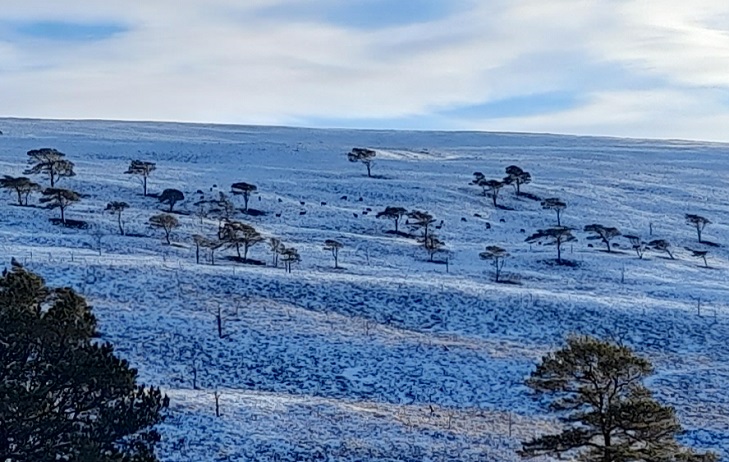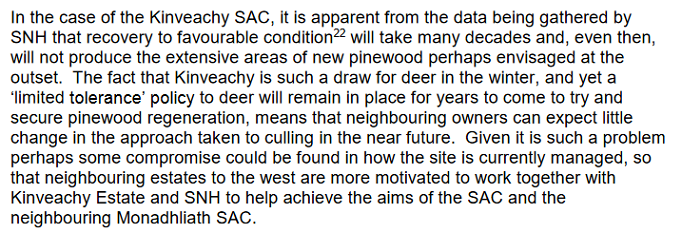
Following the completion of my post on Deer and Peat Bog restoration on the Glen Banchor estate, I was sent a photo by a reader of deer grazing the Caledonian Pine forest remnants at Kinveachy, all of which is designated a Site of Special Scientific Interest and some of which is a Special Area of Conservation.
Strathcaulidh explained the problem in the Monadhliath Strategic Deer Management Plan 2015-24 (see here):

Note 22 states: “The aim of management at Kinveachy is to facilitate regeneration of the pinewoods, and the primary management action is to reduce the level of deer occupancy then maintain it at a level compatible with allowing young trees to establish”.
There is not a hope of that happening if, whenever there is snow or bad weather, Red Deer are forced down the Dulnain/attracted to the Caledonian Forest remnants at Kinveachy where they gobble up any natural regeneration.
Parkswatch has referred to this problem before when considering BrewDog proposals to create and plant new fenced enclosures on the Dulnain as part of their Lost Forest proposal (see here) instead of working with Kinveachy to reduce deer numbers. If Scottish Forestry agrees to pay to BrewDog for further fencing on the Dulnain, it will make the problem downstream at Kinveachy worse, not better as deer will have even less ground to forage in winter.
The photo illustrates the failure of our public agencies to work effectively to protect the Caledonian Pine Forest better than any words.
Postscript
After I published this post it was pointed out to me that readers might think there had been a total failure to restore the Caledonian Pinewood Forest on the Dulnain. I did not intend to imply that and it is not the case: there are areas of natural regeneration at Kinveachy and the fact those are not fenced is a great strength. However, the regeneration is not as extensive as it might be due and is far slower than that on the restoration side of Mar Lodge and in Glen Feshie and that is in part to incursions by red deer. The problem is different estates are working to different objectives and that is undermining the attempts by Seafield Estates to regenerate the pine forest at Kinveachy.

Until NatureScot, the Scottish Government and our National Park Authorities take a much stronger stance on reducing deer numbers these problems will continue to arise. There are still too many large landowners who are in denial. Another recent example of this is in Assynt – see the P&J Article headed, “Assynt deer cull: Legitimate tool to prevent woodland damage or ‘gratuitious killing'” – https://www.pressandjournal.co.uk/fp/news/highlands-islands/5234740/deer-cull-to-protect-woodland-branded-gratuitous-killing/ – where the John Muir Trust is being heavily criticised for a deer cull licensed by NatureScot.
I see some action on deer culling (BBC news 18Jan) Does this mean the Scottish Government is waking up to the problem at last?
A Scottish government agency has said it has culled red deer on a Highland estate because they were damaging protected habitats.
The animals were shot at Loch Choire Estate where large areas of peatlands and woodlands are designated Sites of Special Scientific Interest (SSSI).
NatureScot said the estate’s owner had not responded to requests to manage deer numbers themselves.
It said little or no culling had taken place in recent years.
NatureScot used powers in the Deer (Scotland) Act to have its stalkers carry out the cull.
Sorry about the above layout. Copy and paste did not work well this time!
I hope folks read down the blocks, then it makes sense!
I think this website based article in defence of the John Muir Trusts own interest in full debate of deer management issues, might interest anyone who did not spot its publication this last week. : https://www.johnmuirtrust.org/resources/1367-assynt-deer-dispute-the-myths-and-the-facts